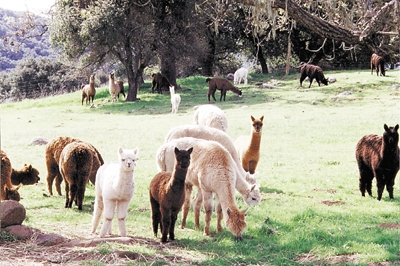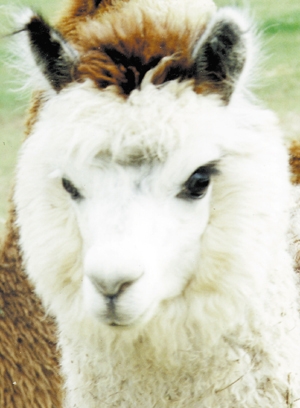For thousands of years, the elegant and beautiful alpaca has roamed the high Andean mountains and plateaus of South America where, it’s said, they live closer to heaven than any other creature. Today, these gentle animals can be found peacefully grazing on ranches and farms all across America, bringing their magic and serenity, and the gift of their exotic fiber to a whole new breed of livestock tenders, from Alaska to Alabama.
A member of the South American camelid family of llamas, guanacos and vicunas, alpacas were bred over 5,000 years ago. Pre-dating even the Inca Empire, llamas and alpacas were the only domesticated livestock in the New World before the arrival of the Europeans, and they were an integral part of the culture and lifestyle of their Andean caretakers. With the Spanish Conquest of the Incas came the almost total annihilation of the alpaca and llama, along with much of the human population. But, bred to be survivors in the unforgiving conditions of the Altiplano, these hardy camelids prevailed.
 Today, the alpaca numbers in the millions once again, but outside their native South America, their population is still very small. They were first imported to the United States in 1984, but because of strict import restrictions, the reluctance of the South American countries to export their animals, and their relatively slow, single-birth reproductive cycle, there are only about 12,000 alpacas in the U.S. today. However, those numbers are steadily growing as more and more people catch their first glimpse of an alpaca, fall in love, and embrace the pastoral lifestyle they promise. Today, the alpaca numbers in the millions once again, but outside their native South America, their population is still very small. They were first imported to the United States in 1984, but because of strict import restrictions, the reluctance of the South American countries to export their animals, and their relatively slow, single-birth reproductive cycle, there are only about 12,000 alpacas in the U.S. today. However, those numbers are steadily growing as more and more people catch their first glimpse of an alpaca, fall in love, and embrace the pastoral lifestyle they promise.
With a look distinctly their own, at once beautiful and whimsical, these remarkable animals have captured the hearts and minds of owners and breeders across the country. Curious but shy, the gentle alpaca embraces its owner with a soulful gaze from enormous eyes, a gentle sniff and the good manners of a well-bred house guest. Respectful of its tenders and its environment, the sweet-tempered alpaca keeps on giving, generously yielding an annual harvest of luxurious fiber throughout a 15 to 25 year life span.
About a third the size of a llama, adult alpacas typically weigh between 100 and 185 pounds. They are intelligent and highly social, easy to care for and handle, appealing to look at and fun to have around. Quiet companions, they communicate mainly through body posturing and gentle humming sound. They hum, it’s said, because they don’t know the words!)
For those with little or no livestock experience, the alpaca is a patient teacher, asking little of her owners. Raised on the harsh high Andean plains, the alpaca has evolved as a hardy and disease-resistant creature. They even have the courtesy to give birth during daylight hours, a trait stemming from their Andean roots where babies needed to be dry and mobile before the freezing cold nightfall. With rare exception, the self-sufficient alpaca welcomes new life with no human intervention. And new babies, called crias, manage to sort out their enormously long legs and neck with remarkable dispatch, standing and nursing with an hour of birth.
 Ten alpacas can comfortably live on the same amount of land it would take to graze one horse. The gentle alpaca never disturbs the earth with its padded feet, and indelicately eats the tops off the grass, always careful to leave a little something for those that follow. Alpacas are remarkably efficient food processors, who can survive on the sparse forage of their native habitat, and who typically cost less than the family dog to feed. Ten alpacas can comfortably live on the same amount of land it would take to graze one horse. The gentle alpaca never disturbs the earth with its padded feet, and indelicately eats the tops off the grass, always careful to leave a little something for those that follow. Alpacas are remarkably efficient food processors, who can survive on the sparse forage of their native habitat, and who typically cost less than the family dog to feed.
The end product of that food cycle is the ultimate in fertilizer, highly prized by home gardeners. The compact pellets are so well processed by the alpaca, in fact, they can even be applied directly to plants with no risk of burning. And they are deposited by the animals in neat communal piles, which keep the fields clean and make pick-up a snap. So tidy and organized are the alpacas, in fact, that they often wait their turn in line at the dung piles, resembling the ladies room queue at Dodgers Stadium.
While most of these sweet animals are diehard homebodies who prefer to stay with their friends on the ranch, they are agreeable travelers. Slide open the door on the minivan or station wagon and, with a little encouragement, they’ll hop in for the ride. When group travel is in order, a small livestock trailer fills the bill. The more adventuresome of the herd have even boarded small planes! Once en route, the alpaca sits down and enjoys the ride.
Alpacas demand so little yet give so much in return. They live life in harmony with nature and share that harmony with their owners. Their peaceful behavior inspires us to slow our hectic pace. Their amusing antics bring smiles to our faces. And their incredible fiber rewards us with a luxurious product, much in demand by fiber artists and fashion couturiers around the world.
Throughout history, alpaca fiber has been highly valued and sought after. The fleece was so revered by Inca royalty, it is said, that commoners found in possession of top-grade alpaca fleeces were sometimes executed for their transgression. Its durability is attested to by discoveries like that on the snow-covered slopes of Peru’s Mount Ampato a few years ago. One of the oldest archeological treasures was carefully wrapped in an alpaca blanket.
 The fiber, which is stronger and more resilient than merino sheep wool, comes in an extraordinary variety of 22 natural colors, ranging from pure white through fawn, to a range of browns and a true jet black. Luxurious garments crafted from the silky fiber have the look and feel of cashmere. Raised at high altitudes in freezing cold, the alpaca has developed more thermal capacity in its fiber than almost any other animal, creating garments that offer featherweight warmth. The fiber, which is stronger and more resilient than merino sheep wool, comes in an extraordinary variety of 22 natural colors, ranging from pure white through fawn, to a range of browns and a true jet black. Luxurious garments crafted from the silky fiber have the look and feel of cashmere. Raised at high altitudes in freezing cold, the alpaca has developed more thermal capacity in its fiber than almost any other animal, creating garments that offer featherweight warmth.
While the value of their exotic fiber will be the economic underpinning of the future market for alpacas, today’s industry is focused on producing and selling high quality breeding stock. Since the industry is relatively new in the U.S. and the number of alpacas here remains small, breeding animals continue to command premium prices. But these gentle, sweet-tempered alpacas also make appealing pets. Think pairs, however, because these sociable little creatures need the companionship and comfort of a pal. They’re easy to train, enjoy going for walks, are gentle enough to be handled by children, and are so well-behaved they even warrant an occasional invitation into the house. And for fiber artists and those who enjoy spinning, weaving, knitting, felting - what better than to have your own fabulous fiber-producing alpacas in the backyard. Alpacas can be sheared each year and typically produce form three to eight pounds of fiber annually. With a life span of 15 to 25 years, that’s a lot of fiber.
As companions or investments, the alpaca promises heart warming and rewarding experiences. Whether regally posed in a lustrous full fleece or comically unclad in its post-shearing profile, the alpaca captures our hearts, renews our spirit, and leads us back to the simple thing that make us smile.
More information about alpacas may be obtained by calling America Alpaca Associates at (888)8ALPACAS.
[For over a decade, Joan Speirs raised llamas and alpacas at her ranch, El Ranchito de las Llamas y Alpacas, in the Santa Ynez Valley of California. In 1994, she introduced Penny Maines, of Lone Juniper Ranch Alpacas in Gorman, California, to these remarkable animals.]
|